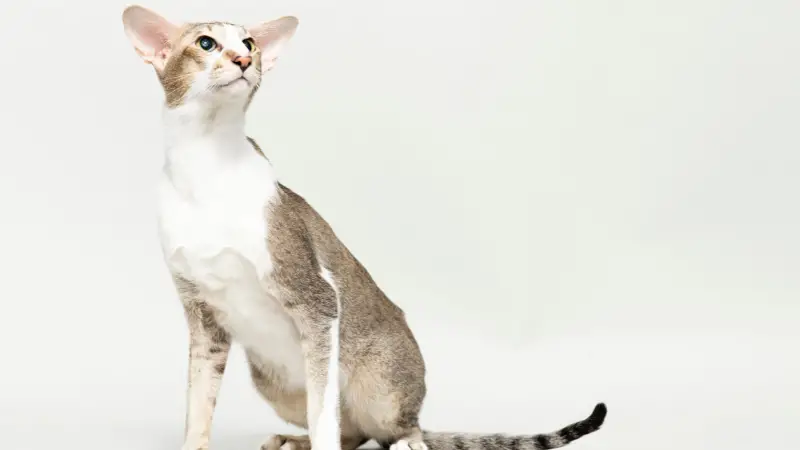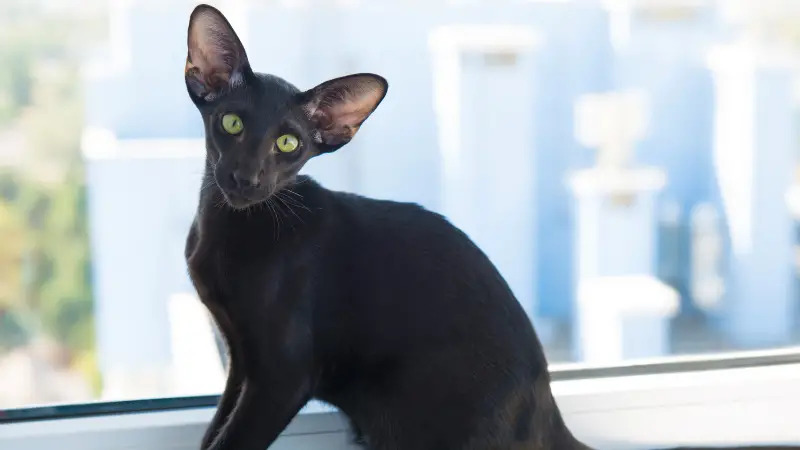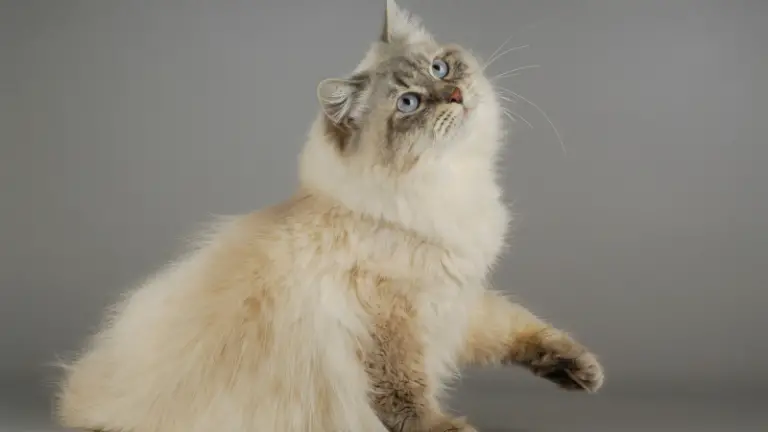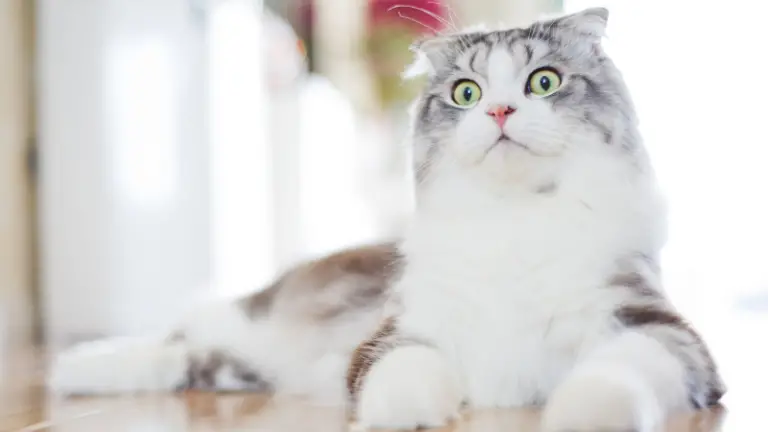ORIENTAL CAT PERSONALITY AND BREED (ALL YOU NEED TO KNOW)
Would you like to know more about the Oriental cat personality? There are more potential varieties in this breed than any other, and literally hundreds of possibilities to choose from.
Some combinations are only theoretical, so they don’t exist yet. Oriental cats are outgoing, loud, and lively. At a glance, the Oriental cat is naturally affectionate, attention-seeking, playful, energetic, and available in many colors and varieties.
Here is all the basic information about the cat personality and breed.

WHAT IS THE ORIENTAL CAT GENERAL ASPECT AND SIZE?
The tapered body, utterly similar to that of the Siamese cat, the elegant position, the adorable character, and the sweet meow makes the Oriental a true miniature masterpiece.
The oriental cat has big, pointed ears that follow the line of the head. He likes to use his paws to attract attention with soft taps and pouncing.
CHARACTERISTICS OF THE ORIENTAL CAT:
| Characteristic | Description | Notes |
|---|---|---|
| In summary | Huge choice in terms of colors and patterns, but some are raised on a larger scale | The solid varieties have still a worldwide following |
| Personality | Very outgoing, lively, and boisterous, he needs attention | |
| Appearance | Beautiful, sleek, and elegant appearance, and the head with a bony profile | |
| In the hose | In order not to get bored, he needs a lot of attention. He should have toys always available | He should always have toys. Take some time to play with him |
| Behavior | He immediately lets himself be absorbed by the members of the adoptive family | |
| Grooming | The short coat should be brushed a once in a while, although the cat loves this operation | Stroking them will be helpful to remove the hairs about to break away |
| Most common health problems | Respiratory infections and sometimes hereditary problems to the heart | |
| Size | Medium, from 4 to 6 kg | |
| Ears | Large, positioned laterally, very much open at the base, and pointed | |
| Eyes | Of medium size, almond-shaped | |
| Head | Wedge-shaped, with a long and straight nose, pink-skinned and outlined in brown | |
| Paws | Tapered, but muscular; the rear ones are longer than the previous ones; oval feet | |
| Coat | Short, close to the body, thin | |
| Admitted colors | Black, white, blue, lilac, red, cream, silver, chestnut, cinnamon, smoky black, brown smoky, smoky cameo, tabby, and scale of turtle. |
In an Oriental cat, the contrast between the white areas and color must be clean.
The beautiful white Oriental British variety has only blue eyes color.
WHAT IS THE HISTORY OF THE ORIENTAL CAT?
At the dawn of the Siamese breed, colorpoint and solid specimens existed between the nineteenth and twentieth centuries. However, by the late 1920s, the latter had practically disappeared once it was decided that only blue-eyed Siamese cats could be exhibited.
The Orientals are a reproduction of the lost lineage, therefore similar to Siamese as “type” but without the characteristic appearance with the colored tips. Their revival began in the 1950s, and the breed now boasts a worldwide following.
No wonder their temperament is very similar to the Siamese, so they are very dynamic cats. They know how to climb and have energetic personalities. Precisely for this reason, it is not easy to ignore them, even in a family where everyone has many commitments.
Orientals are outgoing by instinct, and they have a very playful side.
HOW THE ORIENTAL CATS COLORS CHANGED THROUGH THEIR HISTORY
At first, solid Orientals predominated, but then it began to develop many color varieties. There are twisted tortoiseshell and tabby versions, with the motifs clearly visible thanks to the short and shiny coat.
There are also shaded, smoke, and tipped versions. The two-tone versions are pretty recent, but they have already obtained recognition for North American performances.
WHAT IS THE ORIGIN OF THE ORIENTAL CAT?
The roots of the Oriental cat sink into that extraordinary and mysterious land that is Thailand, as witnessed by a series of representations presented in a book of poems found in the ruins of Ayudha, the ancient capital of Siam, and later confirmed from a recent DNA study of the feline population that country.
The nineteenth century sees the first imports of these gorgeous green-eyed cats and the solid color cape in Great Britain. Like the Siamese cousin in build, he was registered in the same category up to the beginning of the following century.
During the first twenty years of the twentieth century, it was recognized only the Siamese breed, so the Oriental cat disappeared altogether. With the end of World War II, there was an effort to select the Oriental breed again, starting with the intersections between Russian Blue, Siamese, and domestic cats.
In 1960 a new selective line was undertaken based on the intersection of Siamese cats, domestic cats, and Abyssinians. Finally, the Oriental cat was officially and definitively recognized in 1976 and 1977 by the main international associations.
ORIENTAL CAT PERSONALITY

The Oriental cat looks more like a dog than a feline in behavior. Very affectionate cat. He chooses a member to whom he binds profoundly within the family and does not abandon him, not even for a moment. On the contrary, he is continuously searching for pampering and attention.
▷ The Oriental has a friendly character and is well adapted to living with other cats or with other animals.
The Oriental is not a cat for everyone, given his strong personality. Curious and playful, he loves to entertain his family with acrobatic performances and long “conversations.”
▷ The Oriental “pretends” to exercise absolute control over the house’s activities.
If left alone, he becomes rather spiteful. However, he lives well in an apartment with a garden. One of the few flaws of this cat is his strong stubbornness.
AN ADVICE
Make sure that your Oriental never misses constant contact with nature, which is fundamental for this cat with a lively temperament.
BEWARE OF THE COLD!
The weak point of the Oriental cat is the low temperatures.
Long-lived and free from particular problems linked to hereditary defects or genetic heritage, the health of the Oriental can be seriously compromised from a banal cold that makes it easy prey to chills, fever, bronchitis, and pneumonia, with severe consequences.
For this reason, it is advisable never to let it out in winter if not well covered.
CARE AND FEEDING OF THE ORIENTAL CAT
Like most short-haired breeds, it does not require great care: a weekly brushing with a soft or with a buckskin brush during molting is more than enough to maintain a healthy coat.
AN ADVICE
Packaged or fresh food is good for your Oriental cat. But, don’t forget that fish is undoubtedly in the first place among the foods that your Oriental prefers.
Since it has a rather delicate stomach and has very refined tastes, a varied diet based on packaged foods of the highest quality is ideal for this cat. However, don’t overdo the doses; the Oriental is a cat with a good appetite and tends to gain weight.
The Oriental cat needs to move, so the ideal would be to have a garden available.
FREQUENTLY ASKED QUESTIONS
What is the Oriental cat price?
Oriental cats can be expensive; they can cost anything between $800 and $ 2000. The price depends on the breeder, the cat’s age, and the purity of the breed.
Are Oriental short-haired cats affectionate?
Oriental short-haired cats are very affectionate; they like to bond with family members and receive attention. However, they can be stubborn when they have in mind to get something, but they are adorable cats.
Are Oriental cats loud?
Oriental cats can be vocal at times. However, their meows are sweet and soft and not extremely loud.
Are Oriental cats hard to take care of?
Oriental cats are not hard to take care of; they need attention like any other cat, the grooming doesn’t require a long time, but they need to go outside from time to time, so the owner could teach them to walk on a leash.








